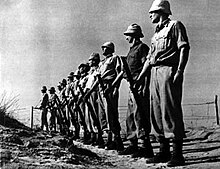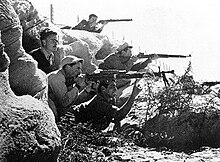Haganah
| Haganah | |
|---|---|
| הַהֲגָנָה | |
 | |
| Active | 1920–1948 |
| Disbanded | 28 May 1948 |
| Country | |
| Allegiance | |
| Type | Paramilitary |
| Role | Defense of Palestinian Jews throughout the British Mandate |
| Size | 21,000 (average)[1] |
| Engagements | |
Haganah (Hebrew: הַהֲגָנָה ha-Haganah, lit. 'The Defense') was the main Zionist paramilitary organization that operated for the Yishuv in the British Mandate for Palestine.[2] It was founded in 1920 to defend the Yishuv's presence in the region, and was formally disbanded in 1948, when it became the core force integrated into the Israel Defense Forces shortly after the Israeli Declaration of Independence.
Formed out of previous existing militias, Haganah's original purpose was to defend Jewish settlements against Arab attacks; this was the case during the 1920 Nebi Musa riots, the 1921 Jaffa riots, the 1929 Palestine riots, the 1936 Jaffa riots, and the 1936–1939 Arab revolt in Palestine, among others. The paramilitary was under the control of the Jewish Agency, the official governmental body in charge of Palestine's Jewish community during the British era. Until the end of World War II, Haganah's activities were moderate, in accordance with the strategic policy of havlagah (lit. 'self-restraint'), which caused the breakaway of the more radical paramilitaries: Irgun and Lehi. Haganah militants received clandestine military support from Poland and sought cooperation with the United Kingdom in the event of an Axis-led invasion of Palestine through North Africa, prompting the creation of the Palmach, their elite fighting force, in 1941.
Following the end of World War II, the British refused to lift the restrictions on Jewish immigration that they had imposed with the 1939 White Paper. This resulted in Haganah leading a Jewish insurgency against the British authorities in Palestine; the campaign included the paramilitaries' bombing of bridges, railways, and ships used to deport illegal Jewish immigrants, as well as assisting in bringing more diaspora Jews to Palestine in defiance of British policies. After the adoption of the United Nations Partition Plan for Palestine in 1947, Haganah came into the open as the biggest fighting force among the Palestinian Jews, successfully overcoming Arab militias during the Palestinian Civil War. Shortly after the beginning of the 1948 Arab–Israeli War, Haganah was merged with other paramilitary groups and reorganized into the official military force of the State of Israel.
History
Overview

The evolution of Jewish defense organizations in Palestine and later Israel went from small self-defense groups active during
The Jewish paramilitary organizations in the
1920 Palestine riots and 1921 Jaffa riots
After the 1920 Nebi Musa riots and 1921 Jaffa riots by Palestinians, the Jewish leadership in Palestine believed that the British, to whom the League of Nations had given a mandate over Palestine in 1920, had no desire to confront local Arab groups that frequently attacked Palestinian Jews.[5][6] Believing that they could not rely on the British administration for protection from these gangs, the Jewish leadership created the Haganah to protect Jewish farms and kibbutzim. The first head of the Haganah was a 28-year-old named Yosef Hecht, a veteran of the Jewish Legion.[7]
In addition to guarding Jewish communities, the role of the Haganah was to warn the residents of and repel attacks by Palestinians. In the period between 1920 and 1929, the Haganah lacked a strong central authority or coordination. Haganah "units" were very localized and poorly armed: they consisted mainly of Jewish farmers who took turns guarding their farms or their kibbutzim.[citation needed]
Following the 1929 Palestine riots, the Haganah's role changed dramatically. It became a much larger organization encompassing nearly all the youth and adults in the Jewish settlements, as well as thousands of members from the cities. It also acquired foreign arms and began to develop workshops to create grenades and simple military equipment, transforming from an untrained militia to a capable underground army.[citation needed]
1931 Irgun split
Many Haganah fighters objected to the official policy of havlagah (restraint) that Jewish political leaders (who had become increasingly controlling of the Haganah) had imposed on the militia. Fighters had been instructed to only defend communities and not initiate counterattacks against Arab gangs or their communities. This policy appeared defeatist to many who believed that the best defense is a good offense. In 1931, the more militant elements of the Haganah splintered off and formed the Irgun Tsva'i-Leumi (National Military Organization), better known as "Irgun" (or by its Hebrew acronym, pronounced "Etzel").[citation needed]
1936–1939 Arab revolt in Palestine

During the 1936–1939 Arab revolt in Palestine, the Haganah worked to protect British interests and to quell the rebellion using the Posh and then the Hish units. At that time, the Haganah fielded 10,000 mobilized men along with 40,000 reservists. Although the British administration did not officially recognize the Haganah, the British security forces cooperated with it by forming the Jewish Settlement Police, Jewish Supernumerary Police and Special Night Squads, which were trained and led by Colonel Orde Wingate. The battle experience gained during the training was useful in the 1948 Arab–Israeli War.[citation needed]
Support from the Second Polish Republic
During the interwar period, as part of its policy of supporting a Jewish state in Palestine in order to facilitate mass Jewish emigration from its territory, the
1939 White Paper
By 1939, the British had issued the
In reaction to the White Paper, the Haganah built up the Palmach as the Haganah's elite strike force and organized illegal Jewish immigration to Palestine. Approximately 100,000 Jews were brought to Palestine in over one hundred ships during the final decade of what became known as Aliyah Bet. The Haganah also organized demonstrations against British immigration quotas.[citation needed]
Bombing of the SS Patria in Haifa

In 1940 the Haganah sabotaged the Patria, an ocean liner being used by the British to deport 1,800 Jews to Mauritius, with a bomb intended to cripple the ship. However the ship sank, killing 267 people and injuring 172.[12][13]
World War II

In the first years of World War II, the British authorities asked Haganah for cooperation again, due to the fear of an Axis breakthrough in North Africa.[citation needed] After Rommel was defeated at El Alamein in 1942, the British stepped back from their all-out support for Haganah.[citation needed] In 1943, after a long series of requests and negotiations, the British Army announced the creation of the Jewish Brigade Group. While Palestinian Jews had been permitted to enlist in the British army since 1940, this was the first time an exclusively Jewish military unit served in the war under a Jewish flag. The Jewish Brigade Group consisted of 5,000 soldiers and was initially deployed with the 8th Army in North Africa and later in Italy in September 1944. The brigade was disbanded in 1946.[citation needed] All in all, some 30,000 Palestinian Jews served in the British army during the war.[14]
On May 14, 1941, the Haganah created the Palmach (an acronym for Plugot Mahatz—strike companies), an elite commando section, in preparation against the possibility of a British withdrawal and Axis invasion of Palestine. Its members, young men and women, received specialist training in guerilla tactics and sabotage.[15] During 1942 the British gave assistance in the training of Palmach volunteers but in early 1943 they withdrew their support and attempted to disarm them.[16] The Palmach, then numbering over 1,000, continued as an underground organization with its members working half of each month as kibbutz volunteers, the rest of the month spent training.[17] It was never large—by 1947 it amounted to merely five battalions (about 2,000 men)—but its members had not only received physical and military training, but also acquired leadership skills that would subsequently enable them to take up command positions in Israel's army.[citation needed]
"The Saison" post-assassination of Lord Moyne
In 1944, after the assassination of
Many Jewish youth, who had joined the Haganah in order to defend the Jewish people, were greatly demoralized by operations against their own people.[19] The Irgun, paralyzed by the Saison, were ordered by their commander, Menachem Begin, not to retaliate in an effort to avoid a full blown civil war. Although many Irgunists objected to these orders, they obeyed Begin and refrained from fighting back. The Saison eventually ended due to perceived British betrayal of the Yishuv becoming more obvious to the public and increased opposition from Haganah members.[19]
Post–World War II


The Saison officially ended when the Haganah, Irgun and the Lehi formed the Jewish Resistance Movement, in 1945. Within this new framework, the three groups agreed to operate under a joint command. They had different functions, which served to drive the British out of Palestine and create a Jewish state.
The Haganah was less active in the
In addition to its operations, the Haganah continued to secretly prepare for a war with the Arabs once the British left by building up its arms and munitions stocks. It maintained a secret arms industry, with the most significant facility being an underground bullet factory underneath Ayalon, a kibbutz that had been established specifically to cover it up.[25]
British estimates of the Haganah's strength at this time were a paper strength of 75,000 men and women with an effective strength of 30,000.[26] After the British army, the Haganah was considered the most powerful military force in the Middle East.[27] Research by Amos Perlmutter estimated that the Haganah budget in 1946 was £400,000, and by October 1947 its budget had reached £3.3 million. The same source estimated that the membership of the Haganah was 7% of the Jewish population in Palestine.[28]
In July 1947, eager to maintain order with the visit of
Reorganization

After "having gotten the Jews of Palestine and of elsewhere to do everything that they could, personally and financially, to help
On 19 November 1947, obligatory conscription was instituted for all men and women aged between 17 and 25. By end of March 21,000 people had been conscripted.[32][33] On 30 March the call-up was extended to men and single women aged between 26 and 35. Five days later a General Mobilization order was issued for all men under 40.[34]
"From November 1947, the Haganah, (...) began to change from a territorial militia into a regular army. (...) Few of the units had been well trained by December. (...) By March–April, it fielded still under-equipped battalion and brigades. By April–May, the Haganah was conducting brigade size offensive.[35]
The brigades of the Haganah which merged into the IDF once this was created on 26 May 1948:
The northern Levanoni Brigade, located in the Galilee, was split on February 22, 1948 into the 1st and 2nd Brigades.
- The 1st or Golani Brigade – was deployed in the Lower Galilee
- The 2nd or Carmeli Brigade – was deployed in the north and took its name after its commander, Moshe Carmel
- The 3rd or
- The 4th or Kiryati Brigade – formed in 1948 in the Tel Aviv area
- The 5th or Givati Brigade – formed in December 1947. During civil war the Givati Brigade was deployed in the central region, and during the conventional war in the south as the 5th Brigade
- The 6th or Etzioni or Jerusalem Brigade – formed on December 1, 1947 and dismantled in the summer of 1949

The Haganah mobilized Jewish youth for military training
To the initial six brigades, three were added later during the war:
- The Holocaust survivors and including a number of Machaltroops. Almost annihilated at Latrun, then re-formed in the north. It had tanks and mounted infantry.
- The 8th Brigade – founded on May 24, 1948, and subordinated to Yitzhak Sadeh as the IDF's first armoured brigade, headquartered near Jerusalem.
- The 9th or Oded Brigade – headquartered in Jerusalem.
The Palmach brigades which merged into the IDF:
- The 10th or Harel Brigade – established on 16 April 1948
- The 11th or Yiftach Brigade
- The 12th or Negev Brigade – established in March 1948
1948 Arab-Israeli War


After the British announced they would withdraw from Palestine, and the United Nations approved the partition of Palestine, the
On May 28, 1948, less than two weeks after the creation of the state of Israel on May 15, the provisional government created the Israel Defense Forces, merging the Haganah, Irgun, and Lehi, although the other two groups continued to operate independently in Jerusalem and abroad for some time after.[19] The reorganization led to several conflicts between Ben-Gurion and the Haganah leadership, including what was known as The Generals' Revolt and the dismantling of the Palmach.
Famous members of the Haganah included Yitzhak Rabin, Ariel Sharon, Rehavam Ze'evi, Dov Hoz, Moshe Dayan, Yigal Allon and Dr. Ruth Westheimer.
The Museum of Underground Prisoners in Jerusalem commemorates the activity of the underground groups in the pre-state period, recreating the everyday life of those imprisoned there.
Pal-Heib Unit for Bedouins
Some
See also
- Jewish Agency for Israel, the organization that governed Haganah
- Sherut Avir, the Haganah aerial service
- Palmach, the elite fighting force of Haganah
- Irgun, a Zionist paramilitary that broke away from Haganah in 1931
- Lehi, a Zionist paramilitary that broke away from Irgun in 1940
- Eliyahu Golomb, the chief architect of Haganah
Notes
- ^ Johnson, Paul (May 1998). "The Miracle". Commentary. 105: 21–28.
- ^ Washington Robnett, George (1976). Zionist Rape of the Holy Land!: How Zionism Turned Palestine Into a Jewish State. Crown City Publishing Company, p. 169.
- ^ Speedy (2011-09-12). "The Speedy Media: IDF's History". Thespeedymedia.blogspot.com. Retrieved 2014-08-03.
- ISBN 9-781789-544633p.96
- ^ "The Role of Jewish Defense Organizations in Palestine (1903–1948)". Jewish Virtual Library.
- ^ Freund, Gabriel; Sahar, Raz (30 May 2013). "Defending the nation for 65 years". IDF Spokesperson.
- ISBN 978-1586481551.
- ^ A Marriage of Convenience: The New Zionist Organization and the Polish Government 1936-1939 Laurence Weinbaum In 1936, an agreement was reached between the Polish government and the Haganah in the person of its emissary, Arazi,
- ^ The Road to September 1939: Polish Jews, Zionists, and the Yishuv on the Eve of World War II (Tauber Institute for the Study of European Jewry) Brandeis University Press 2018 page 57-59
- ^ [1] Betar, Hagana i Irgun w polskiej szkole Polska Zbrojna 25.11.2018
- ISBN 978-1-107-03718-2.
- ^ "The Story of the S/S Patria". Eva Feld. Jewish Magazine. August 2001. Retrieved 10 November 2017.
- ISBN 0-517-53837-7.
- ISBN 0231112009.
- ISBN 978-0-297-00133-1. pp. 116, 117.
- ^ Allon, pp. 125, 126.
- ^ Allon, p. 127.
- ISBN 978-0-7139-9885-6. pp. 355, 356.
- ^ a b c d e Bell, Bowyer J.: Terror out of Zion
- ^ "דף הבית".
- ISBN 978-0-9508367-0-6. pp. 272, 288, 289
- ^ "The Palyam". www.palyam.org. Archived from the original on 2011-08-17. Retrieved 2015-05-13.
- ^ Ben-Yehuda, Nachman: Political Assassinations by Jews: A Rhetorical Device for Justice, pages 227–229
- ^ "דף הבית".
- ^ Kamin, Debra (15 April 2013). "How a Fake Kibbutz Was Built to Hide a Bullet Factory". Haaretz.
- ^ Horne. p. 288, 289.
- ^ The birth of Israel: Long, long road, economist.com.
- ^ Middle East International No 5, August 1971, Publishers Lord Mayhew; Quoted by John Richmond (diplomat) p.33
- ^ Hoffman, Bruce: Anonymous Soldiers (2015)
- ^ Ilan Pappé (2000), p.79
- ^ Efraïm Karsh (2002), p. 31
- ^ Joseph, pp. 23, 38. Gives the date of the call-up as 5 December.
- ^ Ilan Pappé (2000), p. 80
- ^ Levin, pp. 32, 117. Pay £P2 per month. c.f. would buy 2 lbs. of meat in Jerusalem, April 1948. p. 91.
- ^ Benny Morris (2003), pp. 16–17
- ^ "IDF - Israel Defense Forces : Memories of 1948". Archived from the original on 2016-08-19. Retrieved 2015-07-25.
- ^ "אתר הבית של חטיבת אלכסנדרוני". www.alexandroni.org. Archived from the original on 2005-05-26.
- ^ Palestine Post, "Israel's Bedouin Warriors", Gene Dison, August 12, 1948
References
- OCLC 266413.
- Efraïm Karsh (2002). The Arab–Israeli Conflict – The Palestine War 1948. Osprey Publishing. ISBN 978-1-84176-372-9.
- Harry Levin (1997). Jerusalem Embattled – A Diary of the City under Siege. Cassels. ISBN 0-304-33765-X.
- ISBN 978-0-521-00967-6.
- ISBN 978-2-264-04036-7.
- Eugène Rogan; ISBN 978-2-7467-0240-0.
Further reading
- Bregman, Ahron (2002). Israel's Wars: A History Since 1947. London: Routledge. ISBN 978-0-415-28716-6.
- Niv, David (1980). The Irgun Tsva'i Leumi. Jerusalem: World Zionist Organization: Department for Education and Culture.
- "Text of the British White Paper Linking Jewish Agency to Zionist Terrorism in Palestine". The New York Times. July 25, 1946. p. 8.
- Zadka, Dr. Saul (1995). Blood in Zion, How the Jewish Guerrillas drove the British out of Palestine. London: Brassey's. ISBN 978-1-85753-136-7.
- Tobias, Jim G.; Zinke, Peter (2000) [1944–1947]. Nakam — Jüdische Rache an NS-Tätern (in German). Vol. 173 Seiten. Hamburg: Konkret Literatur Verlag. ISBN 978-3-89458-194-7.
- Bergman, Ronen (29 March 2007). "Kollek was British informer". Ynet news.
External links
- Official Haganah website
- The Haganah, from the Jewish Virtual Library
- Lexicon of Zionism: Haganah (Israeli Ministry of Foreign Affairs)
- The Haganah: History of the Israeli Underground Defense force, by the ZIIC
- From Hashomer to the Israel Defense Forces Armed Jewish Defense in Palestine, by Me'ir Pa'il

